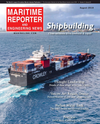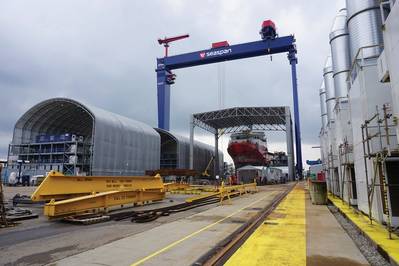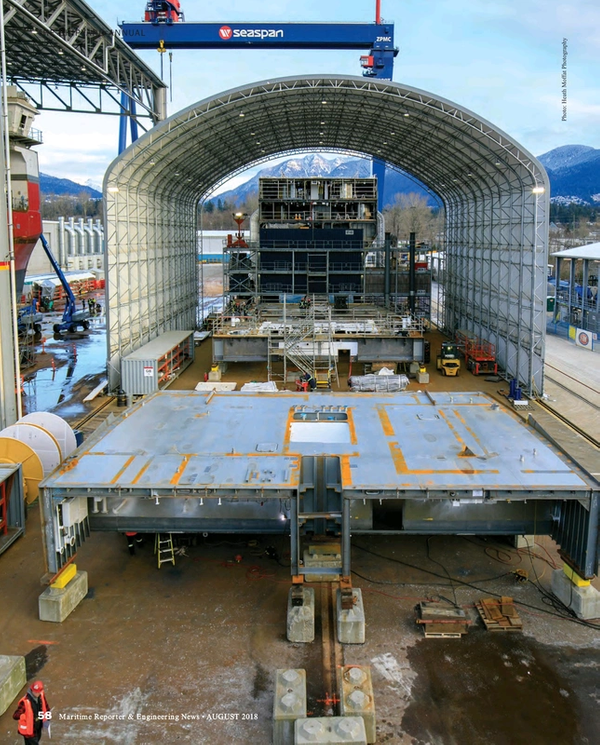
Shipbuilding: Seaspan Shipyards & Building Canada’s Future
There’s a shipbuilding resurgence underway in Canada that’s being driven by a long-term multibillion dollar government initiative to rebuild the federal fleet of Royal Canadian Navy and the Canadian Coast Guard vessels and breathe new life into the country’s shipbuilding industry. Seaspan’s Vancouver Shipyards is an active player.
Under Canada’s National Shipbuilding Strategy (NSS), the Vancouver, B.C. shipbuilder was selected in 2011 to deliver several types of large non-combat vessels for the Navy and Coast Guard, while another shipyard on the East Coast, Irving Shipbuilding, will deliver the combat ships. The NSS also calls for a number of smaller vessels from several other yards throughout Canada.
Vancouver Rising
Seaspan Shipyards won the open competitive bid to build non-combat vessels over 1,000 gross tons in Vancouver. That backlog currently includes three Offshore Fisheries Science Vessels (OFSV), one Offshore Oceanographic Science Vessel (OOSV) and one Polar Class Icebreaker for the Canadian Coast Guard, plus two Joint Support Ships (JSS) for the Royal Canadian Navy. The company anticipates further work on non-combat vessels to be defined by its federal customer in the coming years.
This current and future activity is revitalizing an entire industry by creating new work up and down the shipbuilding supply chain. To date, thanks to its NSS-related work alone, Seaspan has $600 million in committed contracts and engaged approximately 500 Canadian firms, the vast majority of which are small- and medium-sized enterprises.
 Photo: Eric Haun“The National Shipbuilding Strategy is causing a rebirth of shipbuilding on the West Coast, simply put,” said Tim Page, Vice president of Government Relations at Seapsan Shipyards. “We have not had a backlog of work ever such as we have today, nor have we had the promise of that backlog of work because there has not been a federal, national commitment to a long-term strategic recapitalization program for our maritime forces probably since the Second World War.”Prior to the NSS, the shipyard had mostly built tugs, barges and ferries. “Currently, we have three active and concurrent and shipbuilding programs underway, which is a rarity in North American shipbuilding,” Page said. Seaspan is well into the program to produce the three fisheries science vessels, and in June it began building the first of two joint support ships. The yard is also designing, planning and procuring long-lead items for our oceanographic science vessel. Work to produce a polar icebreaker is also due to join the mix.
Photo: Eric Haun“The National Shipbuilding Strategy is causing a rebirth of shipbuilding on the West Coast, simply put,” said Tim Page, Vice president of Government Relations at Seapsan Shipyards. “We have not had a backlog of work ever such as we have today, nor have we had the promise of that backlog of work because there has not been a federal, national commitment to a long-term strategic recapitalization program for our maritime forces probably since the Second World War.”Prior to the NSS, the shipyard had mostly built tugs, barges and ferries. “Currently, we have three active and concurrent and shipbuilding programs underway, which is a rarity in North American shipbuilding,” Page said. Seaspan is well into the program to produce the three fisheries science vessels, and in June it began building the first of two joint support ships. The yard is also designing, planning and procuring long-lead items for our oceanographic science vessel. Work to produce a polar icebreaker is also due to join the mix.
‘Considerable Risk’
Balancing such a workload has its challenges. “It’s a portfolio that includes considerable risk, given the soft-toothed nature of program – three vessels, one, then two, then one,” Page explained. “So, over the first seven vessels that we will be producing here at Vancouver Shipyards, there will be four prototypes, which is a pretty tall order for an industry that has recently been reborn.”
“The federal government has decided that the best way of managing the program in the year to years is to have a series of contracts for each project. So, for the fisheries science vessel we have four separate contracts: an ancillary contract to get us started; engineering contract to do all the design and engineering – preproduction, if you will; a long-lead item contract that allows us to go to market to acquire vendor furnished information, to mature design work and ultimately get costing so that we can have a pretty good idea what it’s going to cost to build the ship so that the government can then get us under contract to build.”
“We don’t have build contracts for the oceanographic science vessel yet,” Page said, “and we have no formal contracts for our polar icebreaker program yet, nor do we have anything but a commitment by our federal government to build up to 10 additional vessels after we’ve completed the polar icebreaker.” The build schedule will ultimately be determined by federal government demand, he explained: “We see this as a 20-year build program. It’s for [the government] to decide how they want to manage that.”
An Ecosystem of Suppliers
All the while, an expanding pool of suppliers is pitching in with Seaspan for the long-term endeavor. “The Canadian market is keenly interested in supporting us,” Page said. “They are, like we, inexperienced in the business by virtue of not having built any large vessels in this country for 30 years. So, we’re all learning together; we’re all in the same classroom, if you will, all trying to figure out how to anticipate our federal customer’s needs, and then how to procure those needs in a timely, cost-effective, quality-driven perspective.”
“That supply base is growing with every successive program that we engage in with our federal government,” Page said. “We’re creating an ecosystem, if you will, that will sustain the efforts of Vancouver Shipyards and responding to the demand of our customer for a long, strategic build program.”
The Canadian government estimates that contracts awarded through the NSS (overall, not just at Seaspan) have contributed some $7.7 billion to the nation’s gross domestic product and create or maintain an average of more than 7,000 jobs per year.
Seaspan Invests
With the promise of steady work through the NSS, Seaspan has invested heavily in its facilities and staff required for the large-scale, long-term project. In 2014, the shipyard completed a two-year $170 million modernization program that included the addition of a very large gantry crane (named Hiyí Skwáyel, the Squamish language translation of “Big Blue”), four fabrication buildings and a load-out pier. “We’ve created here, in our opinion, the most modern shipyard of its kind in North America,” Page said. Additionally, in April this year, Seaspan opened a new 7,800 square meter office next to its yard that will serve primarily as a collaborative space for Vancouver Shipyards to execute preproduction work under the NSS.
With a project of this magnitude also comes demand for a new and larger talent pool. “We are heavily invested in universities, colleges and trade schools. We’re directly invested and indirectly training, and then we’re hoping that graduates of those programs will look at Seaspan Shipyards as a place to earn a well-paid salary and live a productive and enjoyable work experience,” Page said. “We’re also attracting a number of welders, pipe fitters, steel fabricators from the oil and gas sector which is currently experiencing a downturn in Alberta. They’re certified tradespeople, but they have no relative experience building ships. So, we’ve got an active on-the-job training of our blue-collar workforce. And we’re training through apprentices and internships in that respect, as well as in the white-collar area.”
“Given the absence of shipbuilding in Canada and shipbuilding on the West Coast for 30 years, people hadn’t been looking to careers in shipbuilding or ship repair,” Page said. “We’re helping to change that but recognize that we have a responsibility to mature that workforce on a faster pace than simply through the formal education system.”
Progress and Lessons Learned
“As we’re managing a relationship with two different federal customers, figuring out how to flex the muscles of our newly-built shipyard, attracting and training a largely green workforce on both the trade side and the white-collar staff side, and developing a domestic supply chain isn’t used to building ships in this country for the last 30 years, there are considerable risks in all of that. And we are living those risks in real time,” Page said.
The first large vessel designed and built under the NSS, the lead of the three new OFSVs, was launched behind schedule near the end of 2017. “I think the schedule estimates were optimistic when they were first created, in part out of a political imperative to get the shipbuilding strategy underway,” Page said. “We were willing partners in that optimism because we’re very proud of having won the competition, very proud of the work done here in a very short number of years to rebuild Canada’s shipbuilding industry here on the West Coast and to be attracting and training as many young Canadians from diverse backgrounds as we have been able to.”
The milestone vessel, the 63-meter CCGS Sir John Franklin, was launched December 8, 2017. Together with its two sister ships currently under construction, the vessels will replace three aged Coast Guard vessels that are used for research to better understand the health of fish stocks and their ocean environment.
“A first-of-class vessel in a new shipyard always has a myriad of lessons to be learned from it, which we are now applying to the construction of the second and third vessels in that same class. A whole lot in the operations side and the production side, but whole lot as well in the engineering, planning and program management side has been learned. And we’re now applying those lessons learned to our downstream work for the oceanographic science vessel and joint support ship.”
On June 15, Seaspan held a steel cutting ceremony for the first JSS. The new ships will deliver fuel and other supplies to vessels at sea in support of the Navy’s defense and humanitarian missions. They’ll also offer medical/dental facilities and provide support for helicopter operations and equipment repair. Once completed, the 173-meter vessels will be among the largest ships ever constructed on Canada’s West Coast.
Lamarre Named CEO at Seaspan Shipyards
Mark Lamarre, who most recently served as CEO of Australian Shipbuilding Company (ASC), has been named CEO of Seaspan Shipyards effective immediately. Lamarre succeeds Brian Carter, who stepped down to pursue other opportunities. Lamarre’s appointment follows recent Seaspan Shipyards additions to the senior leadership team, including Jari Anttila (previously with Philly Shipyard Inc. and Meyer Turku in Finland) as COO and Christof Brass (previously with Airbus Group SAS) as CFO.
Lamarre is an experienced shipbuilding executive with more 30 years of experience in operations, and business transformation. Most recently, he served as CEO of ASC PTY LTD, where he led a $600m shipbuilding division of ASC engaged in the engineering, construction, activation and post-delivery support of Naval surface combatants to the Australian Navy. Previously, Mr. Lamarre worked at Bath Iron Works, the $1.2 billion shipbuilding business unit of General Dynamics Corporation, where he spent 24 years in increasingly senior roles, responsible for areas such as production engineering, planning, procurement, material control and operations, among others. Lamarre holds an MBA from Boston University’s Questrom School of Business and a Bachelor of Arts.
Read Shipbuilding: Seaspan Shipyards & Building Canada’s Future in Pdf, Flash or Html5 edition of August 2018 Maritime Reporter
Other stories from August 2018 issue
Content
- BIG LIFT: The Importance of the JH143 Builder’s Risk Surveys page: 12
- ShipSure 2.0: Big Data, Bigger Benefits page: 16
- Maritime Thought Leadership: Christopher J. Wiernicki, ABS page: 18
- Maritime Thought Leadership: Remi Eriksen, DNV GL page: 24
- Maritime Thought Leadership: Koichi Fujiwara, ClassNK page: 28
- Thought Leadership: Matthieu de Tugny, COO, Bureau Veritas page: 30
- Shipbuilding: “We had shipyard for dinner …” page: 34
- Shipbuilding: Oman Drydock CEO Aims to Triple Revenue by 2021 page: 40
- Shipbuilder in Focus: DAMEN page: 42
- Shipyard Focus: Vigor page: 48
- Shipbuilding in Sweden: Oresund Dry Docks page: 49
- Cruise Ship Refit: Business Steady at Blohm + Voss page: 51
- Ship Repair: N-KOM Repair Volume Up 25% page: 52
- Shipyard in Focus: Spanopoulos Group - Yacht Repairing and Shipbuilding page: 54
- Shipbuilding in Spain: Astican & Astander page: 57
- Shipyard in Focus: Conrad Shipyard page: 57
- Shipbuilding: Seaspan Shipyards & Building Canada’s Future page: 58
- Finland: A Hot-Bed of ICEBREAKER Technology page: 62
- KVH & Intelsat: On the Digitization Fast Track page: 68
- Shipping Executive Focus: Art Regan, Executive Chairman, Genco Shipping & Trading page: 70
- SMM Interview: Three Questions for Claus Ulrich Selbach page: 98


